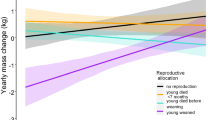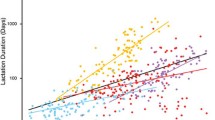Summary
The intrinsic rate of natural increase (r m), conception to weaning time (t cw), age of first reproduction (tmat), and components of fecundity were compared between ecologically similar groups of 42 metatherian (=marsupial) and 42 eutherian mammals. Marsupial t cw s average 50% longer than those of eutherians. Small marsupials (<400 g) mature later, and have lower and r ms than eutherians; large marsupials (>10,000 g) do not mature later but also have lower r ms. At body sizes of 1,000–3,500 g, marsupials and eutherians have similar t mat s and t cw s but marsupials have greater r ms. Marsupials compensate for their longer t cw s by a variety of methods including embryonic diapause, larger litter sizes, and short periods between weaning and maturity. Although the greatest similarities in marsupial and eutherian life histories are at body sizes of 1–5 kg, compensation for long t cw may be seen at any marsupial body size. Other ecological factors not withstanding, marsupial reproduction is neither inherently inferior to that of eutherians nor obviously more advantageous in unpredictable environs.
Similar content being viewed by others
References
Archer M (ed) (1982) The Carnivorous Marsupials. Royal Society of New South Wales, Sydney, Australia
Barnes RD, Wolf HG (1971) The husbandry of Marmosa mitis as a laboratory animal. Int Zool Yearbk 11:50–54
Blueweiss L, Fox H, Kudzma V, Nakasima D, Peters R, Sams S (1978) Relationships ships between body size and some life history parameters. Oecologia (Berlin) 37:257–272
Bolton BL, Newsome AE, Merchant JC (1982) Reproduction in the agile wallaby Macropus agilis (Gould) in the tropical lowlands of the Northern Territory: opportunism in a seasonal environment. Australian J Ecol 7:261–277
Braithwaite R, Lee AK (1979) A mammalian example of semelparity. Amer Nat 113:151–155
Chapman DI, Dansie O (1970) Reproduction and foetal development in female muntjac deer (Muntiacus reevesi Ogilby). Mammalia 34:303–319
Cole LC (1954) The population consequences of life history phenomena. Quart Rev Biol 29:103–137
Davis JA Jr (1965) A preliminary report on the reproductive behavior of the small Malayan chevrotain, Tragulus javanicus, at the New York Zoo. Int Zoo Yearbk 7:42–45
Dapson RW (1968) Reproduction and age structure in a population of shorttailed shrews, Blarina brevicauda. J Mamm 49:205–214
Eisenberg JF (1980) Biological strategies of living conservative mammals. In: Schmidt-Nielson K, Bolis L, Taylor CR (eds) Comparative Physiology: Primitive Mammals. Cambridge University Press, Cambridge, pp 13–30
Eisenberg JF (1981) The Mammalian Radiations. University of Chicago Press, Chicago
Fadem BH, Trupin GL, Maliniak E, VandeBerg JL, Hayssen V (1982) Care and breeding of the gray, short-tailed opossum (Monodelphis domestica). Lab Anim Sci 32:405–409
Fenchel T (1974) Intrinsic rate of natural increase: the relationship with body size. Oecologia (Berlin) 14:317–326
Harvey PH, Mace GM (1982) Comparisons between taxa and adaptive trends: problems of methodology. In: King's College Sociobiology Group (eds) Current Problems in Sociobiology. Cambridge University Press, Cambridge, pp 343–361
Hayssen V (1984) Basal metabolic rate and intrinsic rate of increase: an empirical and theoretical reexamination. Oecologia (Berlin) 64:419–424
Hayssen V, Lacy RC, Parker PJ (1985) Metatherian reproduction: transitional or transcending? Amer Nat 126:617–632
Hennemann WW, III (1983) Relationship among body mass, metabolic rate, and the intrinsic rate of natural increase in mammals. Oecologia (Berlin) 56:104–108
Hennemann WW, III (1984) Intrinsic rates of natural increase of altricial and precocial eutherian mammals: the potential price of precociality. Oikos 43:363–368
Horner BE (1968) Gestation period and early development in Onychomys leucogaster brevicaudatus. J Mamm 49:660–668
Horner BE, Taylor JM (1968) Growth and reproductive behavior in the southern grasshopper mouse. J Mamm 49:644–660
Hvidberg-Hansen H (1970) Contribution to the knowledge of the reproductive physiology of the Thomson's gazelle (Gazella thomsonii). Mammalia 35:552–563
Imbrie J (1956) Biometrical methods in the study of invertebrate fossils. Bull Amer Mus Nat Hist 108:216–252
Irby LR (1979) Reproduction in mountain reedbuck (Redunca fulvorufula). Mammalia 43:191–213
Johnson PM (1978) Reproduction of the rufous rat-kangaroo (Aepyprymnus rufescens Gray) in captivity, with age estimation of pouch young. Queensland J Anim Sci 35:69–72
Kirk RE (1968) Experimental design procedures for the behavioral sciences. Brooks/Cole Publ Co, Belmont, California
Kirsch JA (1977) The six-percent solution: second thoughts on the adaptedness of the Marsupialia. Amer Sci 65:276–288
Lee AK, Cockburn A (1985) Evolutionary Ecology of Marsupials. Cambridge University Press, Cambridge
Lillegraven JA (1975) Biological considerations of the marsupialplacental dichotomy. Evolution 29:707–722
Low BA (1978) Environmental uncertainty and the parental strategies of marsupials and placentals. Amer Nat 112:197–213
Marshall LG (1980) Marsupial paleobiogeography. In: Aspects of Vertebrate History, Jacobs LL (ed) Mus of North Arizona Press, Flagstaff, pp 345–386
McLaren IA (1967) Seals and group selection. Ecology 48:104–110
Messick JP, Hornocker MG (1981) Ecology of the badger in southwestern Idaho. Wildl Mongr 76:1–53
Mock OB (1982) The least shrew (Cryptotis parva) as a laboratory animal. Lab Animal Sci 32:177–183
Morton SR, Recher HF, Thompson SD, Braithwaite R (1982) Comments on the relative advantages of marsupial and eutherian reproduction. Amer Nat 120:128–134]
Newsome AE (1975) An ecological comparison of the two aridzone kangaroos of Australia, and their anomalous prosperity since the introduction of ruminant stock to their environment. Quart Rev Biol 50:389–424
Nowak RM, Paradiso JL (1983) Walker's Mammals of the World. The Johns Hopkins University Press, Baltimore
Parker P (1977) An ecological comparison of marsupial and placental patterns of reproduction. In: Stonehouse B, Gilmore D (eds). The Biology of the Marsupials, University Park Press, Baltimore, pp 273–286
Pinter AJ (1969) Reproduction and growth in two species of grasshopper mice (Onychomys) in the laboratory. J Mamm 51:236–245
Poglayen-Neuwall I, Poglayen-Neuwall I (1980) Gestation period and parturition of the ringtail Bassariscus astutus (Lichtenstein, 1890). Z Saugetierk 45:73–81
Russell EM (1982a) Patterns of parental care and prenatal investment in marsupials. Biol Rev 57:423–486
Russell EM (1982b) Parental investment and desertion of young in marsupials. Amer Nat 119:744–748
Schmitz OJ, Lavigne DM (1984) Intrinsic rate of increase, body size, and specific metabolic rate in marine mammals. Oecologia (Berlin) 62:305–309
Selwood L (1980) A timetable of embryonic development of the dasyurid marsupial Antechinus stuartii (Macleay). Australian J Zool 28:649–668
Simpson GG (1971) The evolution of marsupials in South America. Ann Acad Brasil Cienc 43:103–118
Skinner JD, von Lacherallerie M, van Zyl JHM (1971) An appraisal of the springbok for diversifying animal production in Africa. Anim Breed Abst 39:215–224
Stearns SC (1976) Life-history tactics: a review of the ideas. Quart Rev Biol 51:3–47]
Taylor JM (1968) Reproductive mechanisms of the female southern grasshopper mouse, Onychomys torridus longicaudus. J Mamm 49:303–309
Toweill DE, Toweill DB (1978) Growth and development of captive ringtails. Carnivore 1:46–43
Tyndale-Biscoe H (1984) Mammals: marsupials. In: Marshall's Physiology of Reproduction Vol 1, Lamming GE (ed). Churchill Livingstone, Edinburgh, pp 386–454
Whittle C, Whittle P (1977) Domestication and breeding of Maxwell's durker. Niger Field Nat 42:13–21
Wilson VJ, Clarke JE (1962) Observations on the common duiker Sylvicapra grimmia Linn, based on material collected from a Tsetse control game elimination scheme. Proc Zool Soc Lond 138:487–499
Woolley P (1973) Breeding patterns and the breeding and laboratory maintenance of dasyurid marsupials. Exp Anim 22 (Suppl): 161–172
Author information
Authors and Affiliations
Rights and permissions
About this article
Cite this article
Thompson, S.D. Body size, duration of parental care, and the intrinsic rate of natural increase in eutherian and metatherian mammals. Oecologia 71, 201–209 (1987). https://doi.org/10.1007/BF00377285
Received:
Issue Date:
DOI: https://doi.org/10.1007/BF00377285




